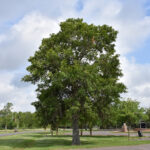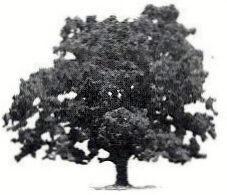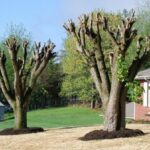Questions and Answers:
Q) Is one tree service just as good as another?
A) No, Unfortunately there is a lot of companies out there doing improper and harmful work to trees while charging for it. Also take in careful consideration, just because a Tree Service is guaranteed or recommended by Google, Angie, BBB, Yelp, Bing, or any other website/lead does not mean the website/lead endorses them for being a good and reputable Tree Service that is known for doing correct and proper tree work. This only means that the Tree Services is paying a premium fee to the website/lead service for a special recommendation. We believe that having our customers recommend our work and business is far more valuable than paying some website/lead service for a bought and payed for recommendation. We recommend all customer looking to have any tree work done, to request references and pictures of previous tree work done by any prospective Tree Services. This will help prevent you from having catastrophic and irreversible damage done to your trees.
Q) How Often Do Trees need to be pruned or worked?
A) After the initial work and clean-up, trees will only need to be maintained every two to three years, as long as they do not sustain any wind or storm damaged before then.
Tree Service that recommends or push to work your trees on an annual basis is only slowly killing your trees while taking your money.
Q) Can Dead or Damage limbs be removed at any time of the year?
A) Yes. Depending on the season and/or the time of the limbs being damage will determine if the dead or damage limb has to be removed in a 2 step process. If the damage or dead limbs is being removed in the proper season for limb removal, then the limb can be removed in a 1 step process. But if the dead or damage limb is being removed out of season for safety reason, then it will have to be removed in a 2 step process that consist in cutting the limb far enough back to prevent the limb in being a safety hazard. Then later in the proper season removing the remainder of the dead or damage limbs with the proper cuts to promote healing.
Q) Can all the Trees be worked at the same time of the year?
A) No, Depending on the type of trees you have, will determine on what season and/or time of year that they can be safely worked on without injuring or damaging it.
Majority of Tree Work:
The Majority of trees can be worked from early springs when they start heavily budding out, up to mid May, at this time the trees sap stops running and any major tree work after this time can keep the tree from healing itself and cause cavities that rot back into the trees limb or main trunk.
Live Oaks:

Although Live Oaks drop their leaves in the springtime and put on new leaves through spring and summertime, the Live Oaks do not start putting new Limb growths until early September and ending early January. This is the proper time to do any major tree work on Live Oaks.
Pecan Trees:

Major tree work on Pecan trees can start late spring when they start heavily budding out all the way through July without affecting nut production. If nut productions is not a concern, then major tree work can be done all the way up to end of August. It is recommended to avoid major tree work on Pecans while they are weeping.
Examples of improper harmful tree work:
 1) Lion-tailing, or ‘poodle-tailing’
1) Lion-tailing, or ‘poodle-tailing’
Is done by stripping branches of all their limbs, except for the branches at the end of the limb. This causes the limbs to look like a lion’s tail. This is extremely bad for the tree, and causes the tree to become stress and eventually causing the limbs to eventually break off due to the excessive weight at the very end of the branch.
Unfortunately this Red Oak Tree is a prime example of improper and bad tree work in many ways. The canopy was raised way above the drip line, leaving the tree like a snow cone shape. This tree was also lion tailed and was left with improper cuts on the remove limbs. (Click on this picture) You can zoom in on this picture and you can see improper cuts done this year, and see the results of past improper cuts that resulted in tree cavity. The tree work was done roughly at the end of September, way after the sap had quit running. This major Tree work should have been done Early Spring when the tree is heavily budding out and no later than mid-May.
Removing major limbs after the sap has quit running can result in cavities developing at the point of limb removal do to either :
1) The Sap does not feed the removed limb area resulting in cavities forming.
2) Causing cut to heal extremely slow, allowing the limb to rot back to the tree resulting in cavities.
Q) Is Topping Trees Out beneficial for them?
A) No, Unfortunately there are an extremely large number of Tree Services out there today that practice this type of harmful and damaging tree work on a regular day to day basis, the irreversible damage is easily seen especially during the winter when the leaves have fallen off the trees, or large branches are seen on a tree that comes to an abrupt end with a bunch of new growth or small limbs shooting out in all different directions back underneath the tree’s canopy. Topping a Trees Out is the last thing or effort one would want to do in trying to save or restore an old or large dying or badly damaged tree.
Topping a tree out or parts of a damaged tree can help in restoring or rejuvenate it if done properly, or it can kill the tree all together, but, whether the work is done during or outside the trees normal growth season (when the sap is running and putting on new limb growth, If the limb or tree survives) this procedure is always a two-step process. Although, the second step of this procedure is done two to three years later depending on how much new growth there is. The largest limb growing in the desired direction is left, and all the other new growth or sucker limbs must be removed, and an additional cut my be required a few inches past the new limb left at this time on the large part of the limb to promote faster healing and to help prevent additional new sucker growth.
Planting Trees:
- Q) When is the best time to Plant Trees, or can Trees be planted any time of year?
- A) Trees can be planted basically any time of year, but, this depending on how long you want to have to water it, or how many times you want to buy a replacement tree. Stores, Nurseys and Tree Farms love to sell people trees in the early springtime and throughout the early summer. This is when they really promote the selling and planting of tree, knowing that a large number to half of the trees they sell will die before the middle of the summer due to improper watering or the lack of watering altogether. Along with knowing that the buyer will come back to buy replacement before the heat of the summer set in, in hope of getting the new tree planted and growing.
The Tree Roots provide water and nutrients in the spring to feeds the developing foliage, leaves, and new limb growth. While the leaves and foliage gathers the nutrients through photosynthesis to feed the roots during the fall and winter. Mid-August to early September, is the best time to Plant all Trees, especially larger trees one caliper inch or larger. You’ll still have to water it until the fall rains starts up, and then you can leave it up to nature to do the rest, by springtime the trees roots will have started establishing themselves and the tree well be on its way to supporting and feeding its self. Planting trees 1 ½ caliper inch and larger will need to be supported by staking it out for a couple of years just to keep it from being blown over by the wind or until it roots are established enough to hold itself up. Much larger diameter and taller trees my need to be staked out and supported up to four years, generally the roots are established enough by this time, that the support stakes and straps can be removed permanently.



